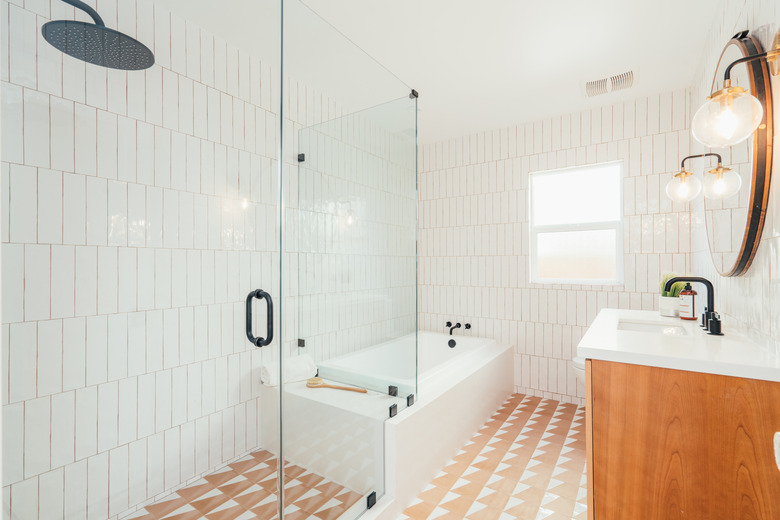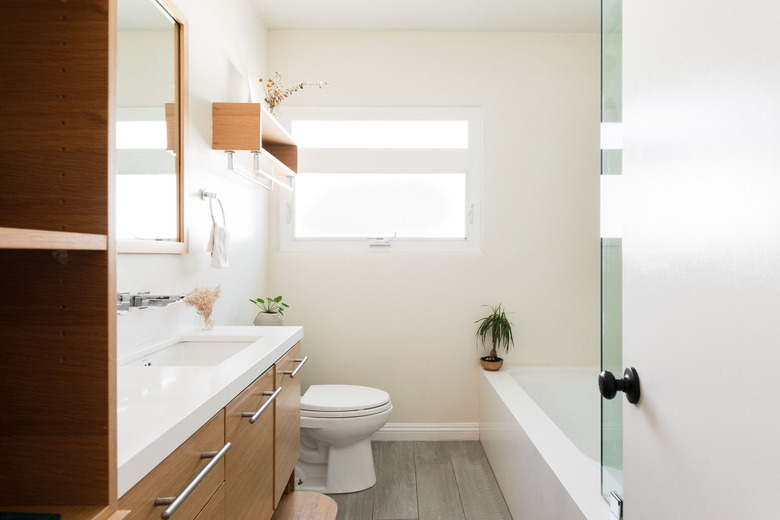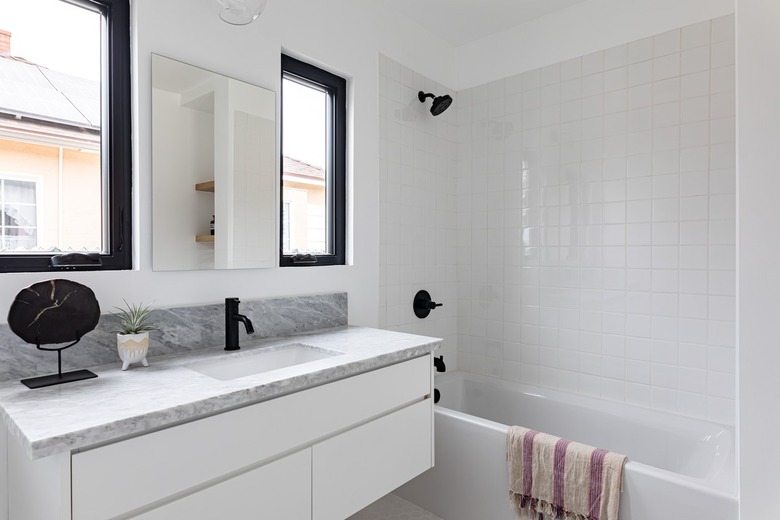Pros & Cons Of An Acrylic Tub
We may receive a commission on purchases made from links.
When it comes to options as far as pricing, color, size and shape are concerned, the acrylic bathtub is hard to match. This type of tub is relatively inexpensive and is lightweight enough to haul upstairs for a second-floor bathroom. With far more styles and shapes available in acrylic than in virtually any other type of tub, you are likely to find one that suits your style and your budget. These tubs do not last forever, however, and they may be damaged by some types of cleaning products.
Acrylic Bathtub Basics
Acrylic Bathtub Basics
An acrylic bathtub is made from sheets of acrylic that are vacuum-formed into a tub shape. Since these are formed over a mold, they can be virtually any type of tub style or design, from drop-in tubs to freestanding tubs that look like classic clawfoot cast iron versions.
Fiberglass is often used as a reinforcing material within the acrylic tub structure. While a true fiberglass tub tends to be porous once some of its coating wears away, an acrylic tub is not porous at all. Fiberglass tubs sometimes wear out in ways that allow water to seep in and through, leading to mildew, mold and potential damage to the home's structure beneath the tub.
Acrylic is one of the more common tub materials thanks to its light weight and its affordability. An empty acrylic tub weighs around 75 pounds on average. By comparison, a cast iron tub weighs upward of 300 pounds, which makes it a difficult option for the average DIY bathroom remodeler. Expect to spend at least $250 for a budget acrylic bathtub or around $500 for the average acrylic tub. Luxury versions can run beyond $900. An acrylic tub also holds heat fairly well, while fiberglass and enameled steel do not.
Acrylic Versus Fiberglass Tubs
Acrylic Versus Fiberglass Tubs
Acrylic and fiberglass tubs share a few common traits, but they have even more differences, especially when it comes to performance over time. As for commonalities, they weigh about the same, although an acrylic tub may be a little heavier. Both are inexpensive choices for bathrooms that are not located on the first floor since they usually will not require extra reinforcement beneath the tub. They both also feel and look a bit like plastic.
Fiberglass is among the least expensive tub materials, running $200 to $500 on average. It is also flimsy enough that it flexes a bit when in use, which may feel awkward and unstable. Acrylic may flex a little but not as much as a fiberglass tub. Fiberglass is also brittle, and it can crack under heavy impact. As its protective coating wears off, exposing the porous fiberglass material beneath, the tub may even warp. Acrylic is more durable and does not damage as easily from weight or impact.
Fiberglass usually only comes in white, whereas acrylic is available in a number of colors. Acrylic comes in far more shapes, styles and sizes than fiberglass and other types of tubs since it is relatively inexpensive to manufacture.
Acrylic Versus Coated Metal Tubs
Acrylic Versus Coated Metal Tubs
While some acrylic tubs look like enameled steel or cast iron from afar, they have only a few similarities. Enameled steel tubs, made by covering a thin layer of steel with a hard enamel coating, weigh about the same as acrylic tubs at around 75 pounds. Enameled steel may be even less expensive than an acrylic tub, starting at under $200. Unlike acrylic or cast iron, an enameled steel tub is generally never a freestanding bathtub (or soaking tub), and is typically seen more in an alcove tub.
Cast iron tubs are made in a similar fashion to enameled steel but with a much thicker, sturdier metal and a thicker enamel coating. They also weigh significantly more, and they typically cost close to $1,000, although some bargains may be found. The coating on both enameled steel and cast iron tubs can chip if a heavy, hard object is dropped on it. Acrylic holds up much better against this type of impact.
On the other hand, enamel and porcelain enamel coatings hold up better to cleaning products, and they are able to handle some abrasives and even harsh chemicals, such as drain openers that splash into the tub. An acrylic tub may become discolored or otherwise damaged from chemicals. Acrylic tubs generally do not last as long as enamel or porcelain over metal for this reason. An acrylic tub usually lasts 10 to 15 years before it becomes faded and significantly scratched, while a quality cast iron tub can last more than 100 years with proper care. An enameled steel tub may last for decades as long as the enamel has not severely chipped.
Acrylic Bathtub Care
Acrylic Bathtub Care
Since acrylic tubs are soft enough to be scratched, it is important to use only nonabrasive cleaners. A few squirts of dish soap in a bucket of water are enough for general tub cleaning with a sponge. If desired, skip the bucket and fill the tub with an inch or two of water instead.
For tougher spots, make an acrylic-safe scouring paste by sprinkling baking soda onto a damp sponge. Do not use steel wool or scouring pads such as the type used for cleaning dishes, as these may scratch the acrylic. A soft-bristled brush may come in handy for stubborn grime.
When dish soap and water are not enough to cut through the crud, try rubbing half of a lemon over the area instead. Equal parts water and vinegar also come in handy for removing grime as well as water spots.
Many chemical cleaners, even those designed to clean tubs and shower surrounds, are too harsh for acrylic. Avoid any products designed to be left in place for a while, such as foaming tub cleaners or tile cleaners. Acetone and other solvents should also be avoided because these may permanently damage the acrylic. Before selecting a bathroom cleaning product, read the label. The warnings section usually states whether the product could harm acrylic and similar materials.


